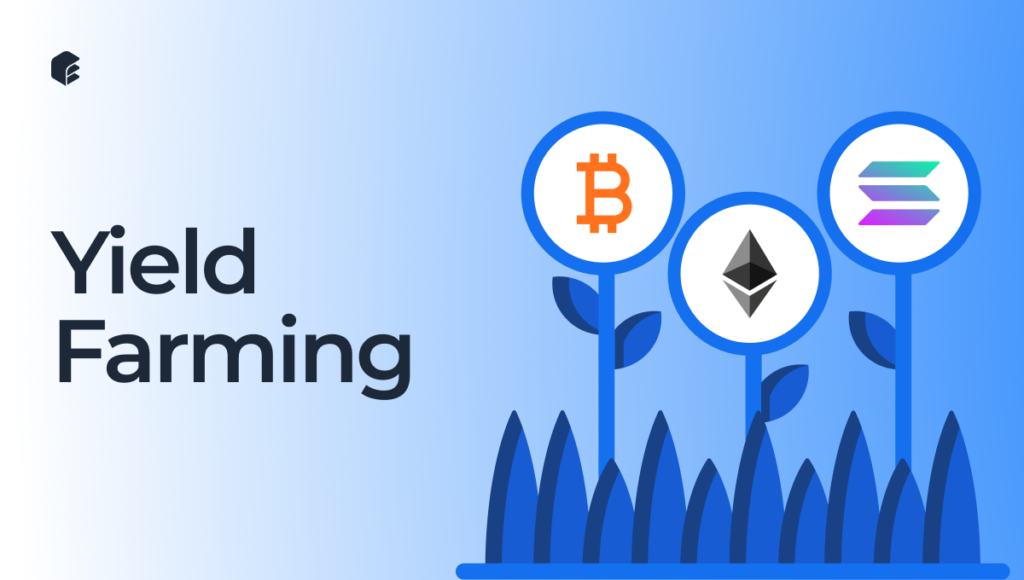Yield Farming: A Comprehensive Guide to Maximizing Crypto Returns

Key Takeaways
-
Advance coin farming represents a sophisticated evolution in DeFi yield farming, introducing advanced strategies that go beyond traditional approaches to optimize returns.
-
Embracing compound yield farming, where rewards are systematically reinvested, coupled with monitoring Annual Percentage Yield (APY), can lead to exponential growth and enhanced profitability for participants.
-
Participants in advance coin farming must balance the allure of potential rewards with a cautious approach, navigating the decentralized landscape, understanding smart contract risks, and adapting to the dynamic nature of the DeFi ecosystem.
In recent years, the decentralized finance (DeFi) ecosystem has witnessed remarkable growth, revolutionizing traditional finance as we know it. One of the key innovations that have driven this progress is yield farming. Yield farming in crypto crenables users to earn passive income by utilizing their crypto assets to provide liquidity to various DeFi protocols. Whether you’re a seasoned DeFi enthusiast or new to the world of cryptocurrency, join us as we dive deeper into the captivating world of yield farming.
What is Yield Farming?
Yield farming, also known as liquidity mining, is a process that allows users to optimize their returns on cryptocurrency holdings. Participants provide liquidity to decentralized exchanges (DEXs) and other DeFi platforms, earning rewards in the form of additional tokens. These tokens may represent governance rights, protocol fees, or other incentives offered by the platform. Yield farmers leverage their crypto assets to earn yields while supporting the overall liquidity of the DeFi ecosystem.
Yield Aggregators: Streamlining the Crypto Farming Experience
To simplify the yield farming process, platforms known as yield aggregators have emerged. These platforms automatically allocate funds to different liquidity pools to maximize returns. Yield aggregators significantly reduce the complexity of yield farming and save time for users.
Automated Market Makers (AMMs): Maximizing Returns in the Crypto Markets
Automated Market Makers are protocols that allow users to trade cryptocurrencies without the need for traditional order books. Instead, AMMs rely on algorithms and liquidity pools to determine the prices of assets. Yield farmers often utilize AMMs to swap tokens and maximize their returns.
How Yield Farming Works: A Step-by-Step Guide

Choosing the Right Platform
Yield farmers must first select a suitable DeFi platform that offers attractive incentives. They should consider factors such as the protocol’s reputation, security measures, and the potential for high yields.
Providing Liquidity
After choosing a platform, the yield farmer locks up their assets in a smart contract, providing liquidity to the platform. In return, they receive liquidity tokens that represent their share of the overall liquidity pool.
Yield Farming Rewards
The farmer earns rewards in the form of additional tokens, which are distributed proportionally based on their contribution to the liquidity pool. These rewards may vary depending on the platform’s governance rules and the user’s staked assets.
Harvesting and Compounding
Some platforms allow users to harvest and compound their rewards automatically. By reinvesting their earned tokens, yield farmers can compound their yields, leading to exponential growth in their overall holdings.
The Strategies of Yield Farming
Yield farming is not a one-size-fits-all approach. It involves various strategies that farmers can employ to optimize their returns. Here are some popular yield farming strategies:
- Single-Asset Staking: This strategy involves staking a single asset, such as Ethereum (ETH), to earn rewards from the platform.
- Pair Staking: Yield farmers provide liquidity by staking two assets, usually in equal value, into a liquidity pool. For instance, providing equal amounts of ETH and stablecoins to a DEX.
- Yield Optimizers: These are automated platforms that help farmers maximize their yields by intelligently moving funds between different liquidity pools.
- Leveraged Yield Farming: Some platforms offer leveraged yield farming, allowing farmers to amplify their rewards by borrowing against their staked assets.
Risks of Yield Farming: Navigating the Crypto Landscape
While yield farming can be lucrative, it’s not without risks. It’s essential to consider the potential challenges involved:
- Impermanent Loss: Due to market volatility, the value of the assets in the liquidity pool may change, leading to impermanent losses when compared to simply holding the assets.
- Smart Contract Risks: Smart contracts are susceptible to vulnerabilities and exploits, exposing yield farmers to potential security breaches.
- Slippage: In highly volatile markets, the execution price may differ significantly from the expected price, resulting in slippage during token swaps.
- Rug Pulls and Scams: Some DeFi projects may be fraudulent or poorly designed, leading to potential losses for yield farmers.
The Rewards of Yield Farming: Earning Interest in the Digital Asset Space
When executed thoughtfully, yield farming can be highly rewarding. Some of the key benefits include:
- High Yields: Yield farmers have the potential to earn significantly higher yields compared to traditional financial products.
- Passive Income: Once liquidity is provided, farmers can earn passive income from their staked assets and reward tokens.
- Governance Rights: Some platforms offer governance tokens, allowing farmers to participate in decision-making processes and influence the platform’s future.
- Contributing to DeFi: By providing liquidity, yield farmers play a vital role in the growth and stability of the DeFi ecosystem.
Advancing Coin Farming: Unleashing the Power of DeFi Yield Farming
As the crypto landscape continues to evolve, one term that has gained significant traction is “advance coin farming.” This innovative concept is closely tied to the broader field of DeFi yield farming, where participants strategically deploy their digital assets to optimize returns.
Defining Advance Coin Farming
Advance coin farming represents a sophisticated approach within the realm of DeFi farming. Unlike traditional methods, it involves leveraging advanced strategies to enhance the yield generation process. This can include dynamic allocation of assets, utilization of yield aggregators, and strategic involvement in multiple DeFi platforms.
Compound Yield Farming: Maximizing Returns Through Compounding
A noteworthy subset of advance coin farming is compound yield farming. This strategy involves the systematic reinvestment of earned rewards to compound overall yields. By utilizing smart contracts and automated processes, compound yield farming allows participants to exponentially grow their holdings over time. This compounding effect is a key driver in achieving higher annual percentage yield (APY).
The Dynamics of APY: Understanding Annual Percentage Yield
Annual Percentage Yield (APY) is a crucial metric in the world of yield farming. It represents the total return on an investment over a year, accounting for the effect of compounding. As participants engage in advance coin farming and compound yield farming, monitoring APY becomes essential for assessing the efficiency and profitability of their strategies.
Transaction Fees and Interest Rates: Factors Shaping Yield Farming
In the decentralized application (dApp) ecosystem, transaction fees and interest rates play pivotal roles. Yield farmers need to carefully evaluate the cost of transactions and the interest rates offered by different platforms. Minimizing transaction fees and maximizing interest rates are essential considerations for optimizing overall returns in advance coin farming.
LP Tokens and Native Tokens: Unveiling the Inner Workings
Liquidity Provider (LP) tokens are a fundamental component of many yield farming strategies. These tokens represent the share of liquidity a farmer contributes to a pool. Additionally, native tokens issued by DeFi platforms often play a vital role in reward distribution and governance. Understanding the dynamics of LP tokens and native tokens is crucial for participants in advance coin farming.
Embracing DeFi Farming: Navigating the Decentralized Landscape
As the DeFi space expands, participants in advance coin farming find themselves navigating a decentralized landscape. Decentralized applications (dApps) form the backbone of this ecosystem, providing the infrastructure for yield farming activities. Engaging with DeFi farming requires users to adapt to decentralized governance, transparent protocols, and the ever-evolving nature of this dynamic space.
Risks and Rewards in Advance Coin Farming
While advance coin farming presents exciting opportunities, participants must be cognizant of potential risks:
- Market Volatility: The crypto market’s inherent volatility can impact the value of assets in liquidity pools, leading to unpredictable outcomes.
- Advanced Smart Contract Risks: Advanced strategies in advance coin farming may involve complex smart contracts, introducing additional risks of vulnerabilities or exploits.
- APY Fluctuations: APY is subject to market conditions and can fluctuate, affecting the overall profitability of advance coin farming strategies.
Conclusion
Yield farming has emerged as a groundbreaking way for crypto enthusiasts to earn passive income and participate actively in the DeFi revolution. By providing liquidity and leveraging various strategies, yield farmers unlock the true potential of their assets. However, it’s crucial to be aware of the risks involved and exercise caution while venturing into the world of yield farming. Research, diversify, and stay informed to make the most of this exciting financial landscape.
Is Yield Farming Risk-Free?
No, yield farming involves risks, including impermanent loss and smart contract vulnerabilities. It’s essential to conduct thorough research and only invest what you can afford to lose.
How Do I Choose the Right Platform for Yield Farming?
Look for platforms with a solid track record, strong security measures, and attractive rewards. Community feedback and audits can also help in the decision-making process.
Can I Lose Money in Yield Farming?
Yes, yield farming carries risks, and it’s possible to experience losses due to impermanent loss or other factors.
How Often Should I Harvest and Compound Rewards?
The frequency of yield harvesting and compounding rewards depends on your risk tolerance and the platform’s tokenomics. Some farmers do it daily, while others follow longer intervals.
What’s the Minimum Investment for Yield Farming?
The minimum investment varies depending on the platform. Some platforms may require a small initial investment, while others may have higher entry barriers.
Is Yield Farming Sustainable in the Long Term?
The sustainability of yield farming depends on the evolution of the DeFi space. As the ecosystem matures, yield farming practices may evolve or change.









